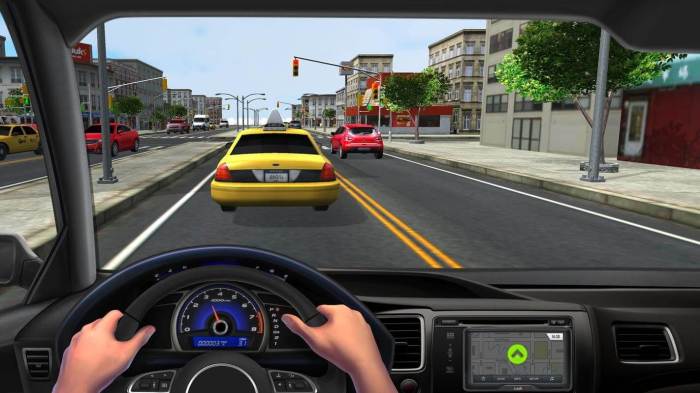
Driving games, a genre of video games that simulates the experience of driving vehicles, have captivated gamers for decades. With their realistic physics, engaging game modes, and stunning visuals, driving games offer an immersive and adrenaline-pumping experience that transports players to the driver’s seat of virtual cars.
From the intricate handling models to the diverse tracks and customizable vehicles, driving games provide a wide range of options to cater to every player’s preferences. Whether it’s competing against AI opponents or engaging in thrilling multiplayer races, driving games offer an unparalleled sense of speed, control, and excitement.
Driving Physics and Mechanics

Driving games aim to replicate the real-world driving experience by incorporating realistic physics and mechanics. These elements play a crucial role in determining the handling, performance, and overall gameplay of the game.
Car Handling Models
Car handling models are mathematical algorithms that simulate the behavior of a car in response to player inputs. Different models offer varying levels of realism and complexity, affecting aspects such as tire grip, suspension behavior, and aerodynamic effects. Some common car handling models include:
Arcade Models
Prioritize simplicity and responsiveness, making them suitable for casual driving games.
Simulation Models
Aim for high accuracy, taking into account factors like tire deformation, weight distribution, and engine torque.
Hybrid Models
Combine elements of both arcade and simulation models, providing a balance between realism and accessibility.
Innovative Driving Experiences
Some driving games push the boundaries of realism by incorporating innovative features and technologies. These advancements enhance the immersive experience, making the player feel more connected to the virtual world:
Ray Tracing
Utilizes advanced graphics techniques to create realistic lighting effects, shadows, and reflections, resulting in stunning visuals.
Motion Capture
Records the movements of real drivers to create highly detailed and lifelike animations for in-game characters.
Force Feedback
Driving games, with their fast-paced action and immersive experiences, can be a thrilling way to unwind. But what if you could enhance your driving experience even further? Consider pairing your driving game with one of the many offline music apps available.
Listening to your favorite tunes while navigating virtual roads can elevate your gameplay, providing an extra layer of immersion and excitement. And with offline music apps, you can enjoy your music without any internet interruptions, ensuring a seamless and uninterrupted driving experience.
Transmits vibrations and forces through the steering wheel or controller, providing tactile feedback that simulates the sensations of driving a real car.
Game Modes and Tracks
Driving games offer a wide range of game modes to cater to different preferences and gameplay styles. These modes include:
- Career Mode:A story-driven mode where players progress through a series of races, earning rewards and unlocking new cars and tracks.
- Multiplayer Mode:Allows players to compete against each other online or locally.
- Arcade Mode:Offers quick and accessible races with simplified rules and often over-the-top gameplay.
Tracks in driving games vary significantly in design and complexity, influencing the gameplay experience. Common track types include:
- City Streets:Realistic recreations of urban environments, featuring tight corners, obstacles, and traffic.
- Race Tracks:Purpose-built circuits designed for high-speed racing, often with long straightaways and challenging corners.
- Off-Road Environments:Natural or artificial terrains with uneven surfaces, obstacles, and varying grip levels.
The design of tracks plays a crucial role in determining the gameplay. Complex tracks with multiple elevation changes, narrow sections, and technical corners require precise driving skills. Conversely, simpler tracks allow for more aggressive and high-speed racing.
Vehicle Customization and Upgrades
In driving games, players have the ability to customize and upgrade their vehicles to suit their driving style and performance preferences. Customization options vary from game to game, but typically include visual modifications such as paint jobs, decals, and body kits, as well as mechanical upgrades that enhance car performance and handling.
Visual Customization
Visual customization allows players to personalize the appearance of their vehicles. This can include changing the paint color, adding decals or wraps, and modifying the bodywork. Some games offer a wide range of customization options, allowing players to create unique and visually striking vehicles.
Mechanical Upgrades
Mechanical upgrades focus on improving the performance and handling of vehicles. These upgrades can include engine performance enhancements, suspension upgrades, and tire upgrades. Engine performance upgrades increase horsepower and torque, resulting in improved acceleration and top speed. Suspension upgrades improve the handling and stability of the vehicle, allowing for better cornering and braking.
Tire upgrades provide better grip and traction, improving overall performance and handling.
Impact of Upgrades on Performance and Handling
Upgrades have a significant impact on car performance and handling. Engine performance upgrades increase acceleration and top speed, making the vehicle faster and more responsive. Suspension upgrades improve the vehicle’s stability and handling, allowing for better cornering and braking. Tire upgrades provide better grip and traction, improving overall performance and handling.
Examples of Games with Extensive Customization Options
Several driving games offer extensive vehicle customization options, including:
- Forza Horizon series
- Need for Speed series
- Gran Turismo series
- Project CARS series
- Assetto Corsa series
Artificial Intelligence and Opponents
Artificial intelligence (AI) plays a crucial role in driving games, as it controls the opponents that players race against. The AI is responsible for determining the opponents’ driving behavior, such as their speed, acceleration, braking, and cornering abilities.
The sophistication of the AI can vary greatly between games. Some games feature simple AI that follows a predetermined path and reacts slowly to the player’s actions. Others employ more advanced AI that can adapt to the player’s driving style, make mistakes, and even learn from their experiences.
Levels of Difficulty
Many driving games offer multiple levels of difficulty to accommodate players of different skill levels. The difficulty level typically affects the AI’s aggression, speed, and overall intelligence. On easier difficulty levels, the AI may be more forgiving of mistakes and less likely to make aggressive moves.
On harder difficulty levels, the AI may be more challenging, requiring players to use more precise driving techniques and strategies.
Examples of Sophisticated AI, Driving games
Several driving games have showcased sophisticated AI that provides a challenging and engaging racing experience. For example:
- Forza Horizon 5:The AI in Forza Horizon 5 uses a machine learning algorithm called Drivatar to create unique AI drivers that mimic the driving styles of real players.
- Gran Turismo 7:The AI in Gran Turismo 7 is designed to mimic the behavior of real-world drivers, taking into account factors such as car setup, track conditions, and the player’s driving style.
- Assetto Corsa Competizione:The AI in Assetto Corsa Competizione is highly realistic and challenging, with opponents that make realistic mistakes and react dynamically to the player’s actions.
Graphics and Visuals
The graphics and visuals of driving games play a crucial role in creating a realistic and immersive driving experience. Advanced graphical techniques are employed to render detailed environments, realistic vehicles, and dynamic lighting effects.
Visual effects, such as particle systems, weather conditions, and lighting, further enhance the gameplay. These effects simulate real-world driving conditions, adding depth and realism to the driving experience. Particle systems create smoke, dust, and debris, while weather conditions affect visibility and traction.
Lighting effects, such as day-night cycles and headlights, create a sense of atmosphere and immersion.
Examples of Games with Stunning Graphics
- Forza Horizon 5:Known for its vibrant and detailed open-world environments, realistic car models, and dynamic weather system.
- Gran Turismo 7:Features stunningly realistic graphics, with meticulous attention to detail in car models and track environments.
- Need for Speed Unbound:Showcases a unique and stylized art style that combines realistic graphics with vibrant effects and particle systems.
Last Point: Driving Games
As technology continues to advance, driving games are becoming increasingly realistic and immersive, blurring the lines between virtual and actual driving experiences. With their innovative gameplay mechanics, stunning graphics, and engaging multiplayer modes, driving games continue to captivate gamers and provide endless hours of adrenaline-fueled entertainment.






